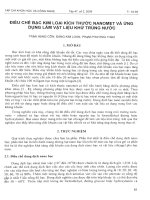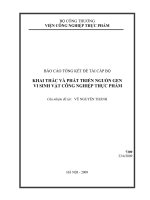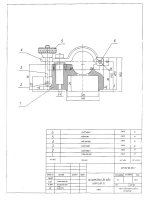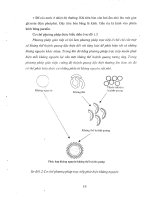Vat Exercises - June 2020 - Ace.pdf
Bạn đang xem bản rút gọn của tài liệu. Xem và tải ngay bản đầy đủ của tài liệu tại đây (249.05 KB, 8 trang )
EXERCISE 1 – DETERMINE CREDITABLE INPUT VAT
VMC Co is a company established in Vietnam, whose main activities include the
manufacture and trading of consumer products. VMC Co had the following transactions
during 2019:
(1) VMC Co purchased materials from a supplier in 2018, for which an invoice with a
value added tax (VAT) amount of VND1,200 million was issued in January 2019. The
invoice was paid in March 2019 via a bank, but VMC Co forgot to claim the input VAT.
In December 2019, when the tax authorities visited the company to audit the period 2016
to 2018, they were aware of this issue, but did not make any decision.
(2) During 2019, VMC Co purchased a 48-seater bus for transporting its employees for
VND2,500 million (exclusive of VAT), and a four-seater car for the general director
costing VND2,200 million (exclusive of VAT).
(3) In August 2019, VMC Co purchased 500 moon cakes for a total value of VND2,750
million (exclusive of VAT) as promotional gifts to clients. The promotion programme
was registered with the relevant tax authorities.
(4) VMC Co purchased goods with an invoiced value of VND8,000 million (exclusive of
VAT). The whole of this inventory was damaged during its transportation to the
company’s warehouse. The insurer agreed to compensate VMC Co for the VAT incurred
in respect of 40% of the goods due to the accident.
Also, in 2019, VMC Co paid for the expenses in relation to the establishment of a branch
in a different province. Before the branch was opened (and obtained a tax code), all
invoices were addressed to VMC Co’s tax codes and addresses (with the specific
authorisation issued to VMC Co by the legal representative of the branch). The total VAT
amount in respect of these invoices amounted to VND3,200 million. Invoices for some of
these expenses with VAT amounting to VND300 million were paid by VMC Co from a
bank account which was intended to be transferred to the branch later. This bank account
has not been registered with the tax authorities as VMC Co’s bank account. The standard
rate of VAT is applicable to all of VMC Co’s VATable sales and purchases.
Required:
(a) Calculate the creditable and/or non-creditable input value added tax (VAT) with
regard to each of items (1) to (4), and briefly explain the reasons for their treatment.
(b) Explain the VAT treatment of the payments made on behalf of the branch, for
both VMC Co and its branch, and calculate the amount of the deductible input VAT
for VMC Co and/or the branch in respect of the expenses for which invoices were
issued to VMC Co.
EXERCISE 2 – DETERMINE INVOICING TREATMENT
(a) SLR Co sold an item of specialised equipment. The equipment was delivered to the
buyer on 31 March 2019, but according to the contract, the title of the equipment would
only be transferred to the buyer upon completion of inspection by the buyer. The
inspection was completed on 2 April 2019 and full payment was made to SLR Co on 6
April 2019.
Required:
State, giving reasons, when for the purposes of value added tax (VAT) SLR Co is
required to issue an invoice for the sale of the equipment.
(b) SHL Co, a Vietnamese company, operates several petrol stations in Ho Chi Minh City.
The petrol stations are also convenience stores where food, drinks and various other items
are sold.
Required:
For the purposes of value added tax (VAT):
(i) State when it is compulsory for SHL Co to issue an invoice to a customer whose
purchases have a value of less than VND200,000.
(ii) Explain the requirements for the issuance of invoices by SHL Co in the case of a
customer whose purchases have value of more than VND200,000 and who does not
require an invoice, for the sale of:
(1) petroleum; and
(2) other items sold by the convenience stores.
(c) HGV Co (HGV) provides internet ADSL services. HGV entered into a contract with
Customer A in June 2015, under which HGV is required to set up a leased line for
Customer A, and then provide internet services for a monthly fixed fee of VND6 million
(inclusive of value added tax (VAT)). Under the contract, the service period for fee
calculation is: from the first day to the last day of the month (or pro rata). HGV collected
the set up fee for the leased line of VND5 million from Customer A in advance on 15 June
2019 and then completed the leased line set up on 20 June 2019. Customer A officially
commenced using the line from 21 June 2019.
Required:
(i) State the general value added tax (VAT) regulatory requirements regarding the
point in time when a service provider is required to issue an invoice, and the point in
time when HGV Co is required to issue the invoice for the set up fee to Customer A.
(ii) Calculate the total output VAT which HGV Co should charge in the VAT
invoice(s) issued to Customer A in June 2019 under the above contract.
EXERCISE 3 – DETERMINE OUTPUT VAT, INVOICING TREATMENT
(a) CSN Co operates a golf course in Ha Long, Quang Ninh province. The company’s
information regarding golf course income for the period ended 30 June 2018 is as follows:
– Membership fees from players: VND16,000 million
– Sales of tickets for golf training ground: VND6,000 million
Note: The collections are inclusive of value added tax (VAT) at 10% and special sales tax
at 20%.
Required:
Calculate the taxable revenue for value added tax (VAT) purposes and the output
VAT which CSN Co should declare for the period ended 30 June 2018.
(b) THD Co is the manufacturer of pharmaceutical products. The company’s
manufacturing facility and headquarters are located in Ho Chi Minh City. The company
has dependent branches in various provinces in Vietnam, including Vinh Phuc. The whole
group adopts the deduction method for VAT declaration purposes.
Required:
Briefly describe the invoicing requirements for both THD Co and the dependent
branch in Vinh Phuc province (i) when THD Co issues goods to the branch; and (ii)
when goods are sold by the branch.
EXERCISE 4 – DETERMINE VAT LIABILITY
(a) EMRT Co is a chain of retail convenience stores operating in Vietnam, which has been
registered for issuing customised computerised invoices since its establishment in 2015.
EMRT Co expects to receive a tax audit in 2018 and the newly appointed chief accountant
has concerns about the invoicing requirements in the following cases:
Case 1: Customer A’s purchases regularly exceed VND200,000 but he refuses to request
invoices. Is EMRT Co required to issue invoices to Customer A?
Case 2: Each of Customer B’s purchases has a value of less than VND200,000, so EMRT Co
has no obligation to issue an invoice unless specifcally requested by Customer B. Is EMRT
Co required to do anything else?
Case 3: EMRT Co issued an invoice to Customer C. When the invoice was handed to
Customer C, the parties identifed that although the tax code shown on the invoice was
correct, the address of the customer was incorrect. Is EMRT Co required to issue a revised
invoice?
Required:
Explain the invoicing requirements for each of the cases 1 to 3 above as asked about by
the chief accountant.
(b) RETM Co is a real estate developer. In 2016, RETM Co purchased the land use right in
relation to a 3,750m2 piece of land in Binh Duong for VND115,500 million (inclusive of
value added tax (VAT) on infrastructure) from TTN Co. The invoice issued to RETM Co
by TTN Co was as follows:
Selling price (net of VAT)
Less: Land-use-right value (exempt from VAT) (VND22
million per m2)
Equals: value of
infrastructure
Output VAT (10% of VND30,000
million)
Total amount payable (112,500 +
3,000)
VND
million
112,500
(82,500)
30,000
3,000
115,500
RETM Co subsequently built 15 villas on the land at a total development cost of
VND49,500 million (including VAT of VND4,500 million). In June 2017, RETM Co
sold all of the villas to clients for VND13,800 million (net of VAT) each. RETM Co
agreed with the tax authorities that it would deduct the allocated land-use-right plus
infrastructure costs as charged by TTN Co based on the area (m2) from the VAT-taxable
revenue of each villa.
Required:
Calculate the output value added tax (VAT) which RETM Co can charge on the
invoice for each villa sold after deduction of the land-use-right and infrastructure
costs, and the total VAT payable to be declared by RETM Co in June 2017.
EXERCISE 5 – DETERMINE CREDITABLE INPUT VAT
FNF JSC is a company which was established in Vietnam in 2013. The company generates
revenue from transportation activities. These activities include public transportation by
buses and other transportation activities. Under a feasibility study, the estimated revenue
allocation between public transportation by buses and other transportation activities is 65%
and 35% respectively. According to prevailing regulations, public transportation by buses is
exempt from value added tax (VAT).
FNF JSC was in the construction and investment period from 1 January 2013 to 31 August
2014. The total amount of input VAT arising from non-current assets during that period was
VND80,000 million, of which VND20,000 million related to the buses specifcally used for
public transportation activities. FNF JSC started generating revenue from September 2014.
The revenue generated between September 2014 and August 2017 was as follows:
Revenue (unit: VND million)
September 2014–August 2015
September 2015–August 2016
September 2016–August 2017
Public transportation
by buses
80,000
120,000
150,000
Other transportation
activities
32,000
41,000
77,000
Required:
(a) Calculate the total creditable or refundable input value added tax (VAT) which
FNF JSC can claim in respect of the purchase of non-current assets as at 31 August
2014.
(b) (i) Explain the appropriate tax treatment with regard to the creditable input VAT
relating to the non-current assets of FNF JSC during the three-year period from
September 2014 to August 2017, and calculate the adjustments needed, if any, to the
creditable input VAT.
(ii) State the daily rate of late payment interest applicable as at August 2017, and
determine the amount of late payment interest, if any, on any adjustments in (b)(i)
above.
EXERCISE 6 – DETERMINE VAT REFUND
VRF Ltd is a Vietnamese company specialising in the manufacture of instant noodles for
both domestic sale and export. Domestic sales and exports of instant noodles are subject to
value added tax (VAT) at the rates of 10% and 0%, respectively. VRF Ltd frequently
applied for and received the VAT refund up to and including May 2016. The total amount
of the VAT refund VRF Ltd received for May 2016 was VND4,770 million. Input VAT
carried forward from May 2016 was VND3,180 million.
Due to the change in the VAT regulations according to Circular 130/2016, VRF Ltd ceased
all VAT refund applications in June and July 2016, but in August 2016 the company
reconsidered and applied for a VAT refund of the input VAT arising in June 2016,
following the new principles for VAT refund set out in Circular 130/2016. The total
creditable input VAT arising during June 2016 was VND4,000 million (not including any
amount carried forward from May 2016), which VRF Ltd could not separate between
domestic sales and exports. The following information (exclusive of VAT, where
applicable) is available for the months of May and June 2016:
Jun-16
Revenue from domestic sales
VND millions
60,000
Revenue from exports
VND millions
32,200
Required:
Estimate (in VND millions) the amount of the VAT refund which VFR Ltd can apply
for in June 2016, if the refund application is required to follow the VAT refund
principles set out in Circular 130/2016.









